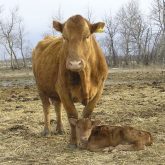Healthy cattle production relies on good vaccination strategies.
The general public is now hearing about efficacy of COVID-19 vaccines, two doses of vaccine, storage and the logistics of transport. We are now hearing about supply issues. With a single-dose vaccine of 66 per cent efficacy, is that worse or better that needing two doses to reach 95 per cent efficacy?
It all still comes down to the basic principles of herd immunity. Getting the masses vaccinated along with exposure levels and pre-existing diseases will determine the outcome. Vaccination is never going to be 100 per cent, but it could save the day.
Read Also

Mosquito-borne virus could be devastating to sheep breeding operations
Cache Valley virus, a mosquito-borne disease that infects small ruminants, could be a devastating hit to small operations.
Our cattle vaccines have been doing this for lots of years with generally good success.
There are so many out there and if I go to print them all from the compendium, four pages of individual vaccines come up. This is why having a herd veterinarian who knows your area, herd, management style and type of cattle is key in picking the right combination for you.
Vaccines have to pass clinical trials for efficacy and safety not dissimilar to what is happening with the COVID-19 vaccine trials. All vaccines run the rare risk of allergic reactions, which is why there is warning on all the cattle vaccines to give epinephrine (so every producer should have some in his/her emergency kit).
The Beef Cattle Research Council is supporting more research towards making vaccination programs more efficacious. Improving manufacturing, duration of protection, handling/storage, multiple combinations and ease of administration are all ways to increase efficacy. Then we must all try and get fellow producers to vaccinate and follow a routine vaccination program.
This is why I advocate that in bull sale and female sale catalogues (as well as online marketing of cattle), the health parameters including the vaccination status is put on. That way we can all share in the benefit of well-vaccinated cattle and if any gaps are determined for your operation, you can address them.
All vaccines are tested and the vaccines from different companies protecting for the same diseases will be pretty darn comparable. If a vaccine comes out and there are too many adverse events — such as allergic reactions or vaccine failures — they don’t stay on the market long. This is very rare with the amount of testing that is done ahead of time. Companies spend a lot of money developing these vaccines, so it is in their best interest to put out an efficacious product.
The core vaccines that are used pretty much without exception are for the clostridias, the core respiratory pathogens (including the viruses IBR, BVD, PI3 and BRSV) and the bacterial respiratory pathogens (histophilus, mannheimia and also pasteurella). Pasteurella is not as common in the vaccines and the pathogen histophilus causes other issues such as joint, heart and brain forms of the disease which also you get protection for. Likewise the IBR can cause abortions and BVD reproductive losses or persistently infected calves, so that vaccine gives this protection as a secondary benefit.
Most, if not all, of these diseases can be vaccinated for with as little as two shots and, of course, booster doses as required. Everyone’s management system is different and depending on when calving turnout to pastures and weaning occurs will help us decide what time frame to give the vaccines and which combination may be best. Killed, live or intranasal vaccines are the newest choice you have on method of administration.
There are three major pharmaceutical companies that have a complete line of vaccines and from there one chooses clostridias that are a little broader spectrum and contain tetanus or redwater, which are not in all the clostridial vaccines. Also, any time you give histophilus in combination with clostridials, tetanus is NOT part of the combination.
The only other vaccine I would say is a core vaccine is the additional scours vaccines given to breeding cows and heifers. Again, not all herds vaccinate but for most (especially if they calve in the winter months), it has become a good management choice. Three companies manufacture scours vaccines and they are all very similar in coverage — it is the timing before calving that is critical. Keep in mind calving occurs over at least a two-month period, so not every cow will be in the ideal period when vaccinated.
Other vaccines — such as those for anthrax, leptospirosis, foot rot, pink eye, and vibriosis — would be others that may be added if any of these is a problem in your herd or local area. And the list goes on. There are vaccines for mastitis in the dairy industry and I am sure vaccines for mycoplasma and Johne’s have been contemplated and even maybe some research put towards. Just like with COVID-19, there are some very bright minds working in the large pharmaceutical companies, so new improved and different methods of administration will come in the future. I was actually surprised that the COVID-19 vaccine didn’t come out intranasally as there is a corona intranasal vaccine approved for cattle so that technology has already been used in animal production.
















